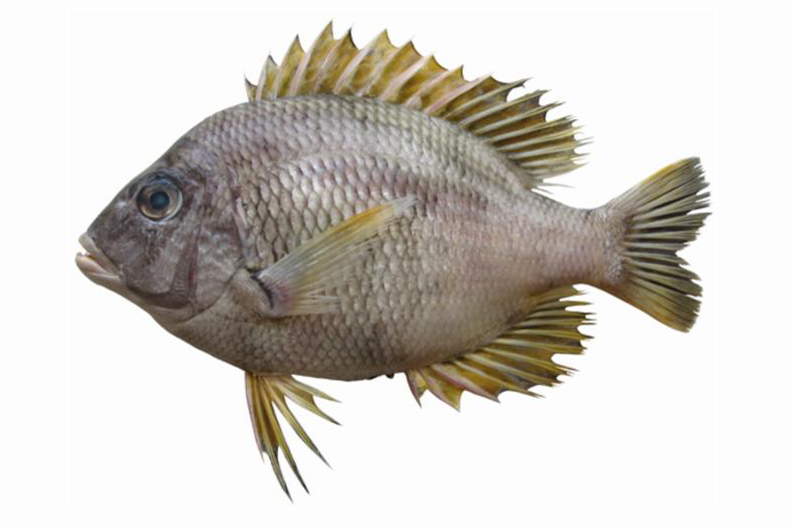- Classification
- ACTINOPTERYGII
- PERCIFORMES
- LETHRINIDAE
- Wattsia
- mossambica
Mozambique Seabream, Wattsia mossambica (Smith 1957)
Other Names: Large-eye Sea Bream, Large-eye Seabream, Large-eyed Bream, Mozambique Large-eye Bream

Mossambique Seabream, Wattsia mossambica. Source: Australian National Fish Collection, CSIRO. License: CC by Attribution-NonCommercial
Summary:
A silver-grey seabream with a yellowish tinge, sometimes with diffuse blotches or bars, yellow lips, yellow fins sometimes with pale brown spots, and a dark bar across the pectoral-fin base.
Cite this page as:
Bray, D.J. 2022, Wattsia mossambica in Fishes of Australia, accessed 10 Jul 2025, https://fishesofaustralia.net.au/home/species/538
Mozambique Seabream, Wattsia mossambica (Smith 1957)
More Info
|
Distribution |
North West Shelf, WA, to the Timor Sea north-west of Darwin, Northern Territory, and the Coral Sea off the northern Great Barrier Reef, Queensland, to off Ballina, New South Wales; may also occur in the Lord Howe Province in the Tasman Sea. Elsewhere the species occurs in the tropical, Indo-west-central Pacific. |
|
Features |
Dorsal fin X, 10; Anal fin III, 10. Scales absent from inner surface of pectoral fin axil; longitudinal denticulate ridge present on maxilla; caudal fin forked with distinctly rounded lobes. |
|
Colour |
Silvery-grey with a yellowish tinge, brownish scale margins, sometimes with indistinct dark blotches or bars on body; dark bar across pectoral-fin base; soft dorsal, anal, and caudal fins sometimes with faint brown spots. |
|
Feeding |
Feeds on benthic invertebrates and small fishes. |
|
Fisheries |
Of minor commercial importance in some areas. |
|
Etymology |
The species is named mossambica after Mozambique, the type locality. |
|
Species Citation |
Gnathodentex mossambicus Smith 1957, Ann. Mag. Nat. Hist. 12 10: 122. Type locality: Pinda reef, 14°10'S, Mozambique, western Indian Ocean, depth 70 fathoms. |
|
Author |
Bray, D.J. 2022 |
|
Resources |
Mozambique Seabream, Wattsia mossambica (Smith 1957)
References
Carpenter, K.E. 2001. Sparidae, Lethrinidae. pp. 2990-3050 in Carpenter, K.E. & Niem, V.H. (eds). The Living Marine Resources of the Western Central Pacific. FAO Species Identification Guide for Fisheries Purposes. Rome : FAO Vol. 5 2791-3379 pp.
Carpenter, K.E. & Allen, G.R. 1989. FAO Species Catalogue. Emperor fishes and large-eye breams of the world (family Lethrinidae). An annotated and illustrated catalogue of lethrinid species known to date. FAO Fisheries Synopsis. No. 125, Vol. 9. Rome : FAO 118 pp.
Carpenter, K.E., Lawrence, A. & Myers, R. 2016. Wattsia mossambica. The IUCN Red List of Threatened Species 2016: e.T16721842A16722465. https://dx.doi.org/10.2305/IUCN.UK.2016-3.RLTS.T16721842A16722465.en. Accessed on 08 February 2022.
Chan, W.L. & Chilvers, R.M. 1974. A revision of the Indo-Pacific spariform percoids of the Monotaxinae, with the description of a new genus Wattsia. Hong Kong Fisheries Bulletin 4: 85-95.
Fricke, R., Kulbicki, M. & Wantiez, L. 2011. Checklist of the fishes of New Caledonia, and their distribution in the Southwest Pacific Ocean (Pisces). Stuttgarter Beiträge zur Naturkunde. Serie A (Biologie) Neue Serie 4: 341-463.
Gloerfelt-Tarp, T. & Kailola, P.J. 1984. Trawled Fishes of Southern Indonesia and Northwest Australia. Jakarta : Dir. Gen. Fish. (Indonesia), German Tech. Coop., Aust. Dev. Ass. Bur. 406 pp.
Kramer, S.H., Kramer, S.M. & Newman, S.J. 1994. New deep-water fish records from the Great Barrier Reef, Australia. Pacific Science 48(1): 70-79. http://hdl.handle.net/10125/2198
Randall, J.E., Allen, G.R. & Steene, R. 1997. Fishes of the Great Barrier Reef and Coral Sea. Bathurst : Crawford House Press 557 pp. figs.
Sih, T.L., Cappo, M. & Kingsford, M. 2017. Deep-reef fish assemblages of the Great Barrier Reef shelf-break (Australia). Scientific Reports 7: 10886. https://doi.org/10.1038/s41598-017-11452-1
Smith, J.L.B. 1957. Deep-line fishing in northern Mozambique, with the description of a new pentapodid fish. Annals and Magazine of Natural History (Ser. 12) 10 (110): 121-124, pl. https://doi.org/10.1080/00222935708655937



